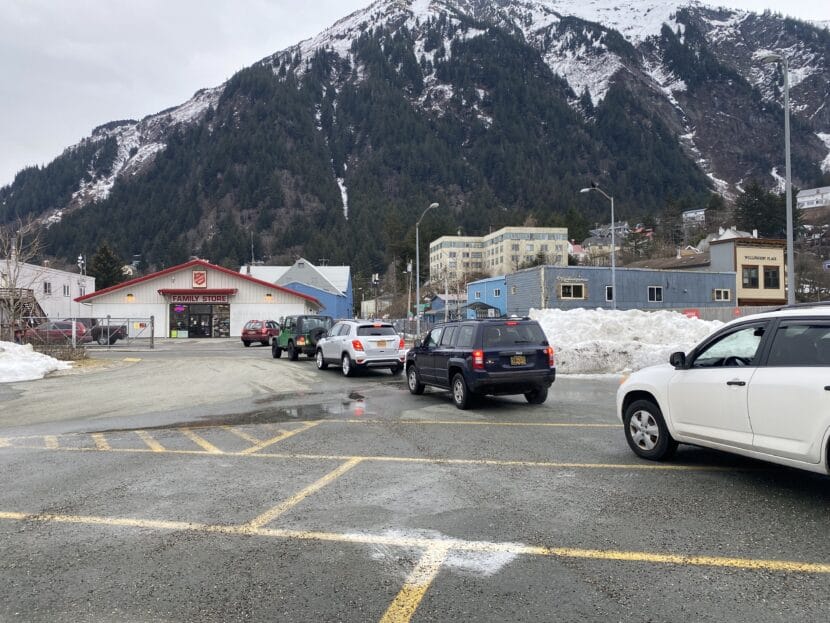
Dick Wood wrestled white garbage bags and cardboard boxes from the backseat of his beat up red car.
There were children’s books, toys and clothes that once belonged to Wood’s son, who is 35 now with a brand new baby.
“We were saving it for his kid, and they don’t want it,” Wood said. “His generation, they don’t want clutter.”
Wood pulled out a yellow, plastic hobby horse mounted on a rusted blue frame, then a crib with a sun-faded orange cover.

“Vintage,” Wood said. “Vintage is hot!”
When Juneau residents want to get rid of their vintage wares — or their junk — they can line up for Saturday donation days at the Salvation Army Family Store. Behind Wood, there are dozens of cars waiting. They spill over into the parking lot across the road.
Everything that’s dropped off gets packed into a shipping container in the store’s back parking lot. Once that fills up, anyone left waiting in line is turned away. Sometimes, the store gets so full that they have to stop taking donations altogether.
That’s left people like KTOO listener Mary McEwen with would-be donations piling up in their attic or the trunk of their car.
“I mean, a lot of us have a bag somewhere that’s like, ‘Oh man, next time I have time on a Saturday morning for that one window where you can drop things off at Salvation Army,” McEwen said.
For this installment of Curious Juneau, McEwen asked KTOO to find out why it’s so hard to get rid of things in town — and what alternatives are there when the thrift stores fill up.
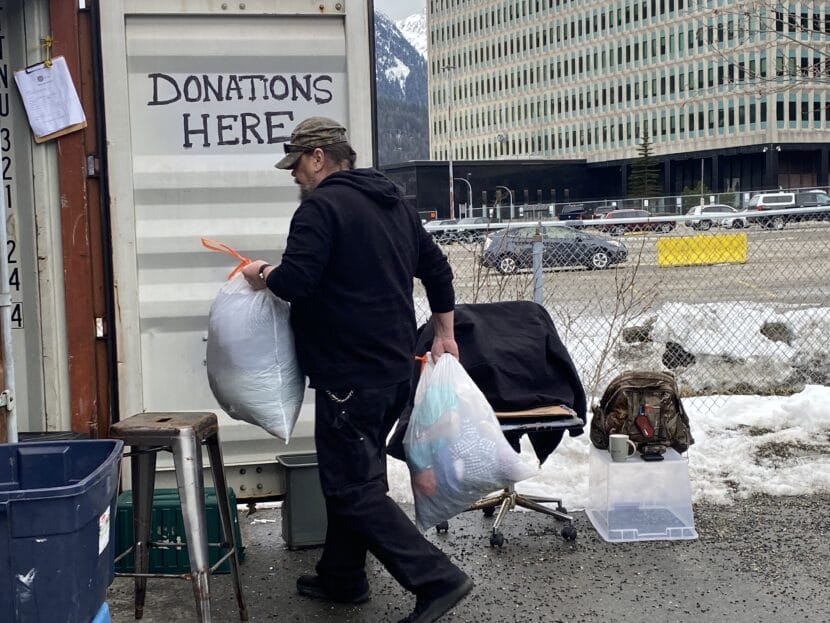
Everything — including the kitchen sink
On a sunny Saturday in February, Salvation Army store manager Christina Austin was all bundled up. But the weather hinted of spring. That usually leads to a spike in donations.
Juneau’s many seasonal residents also contribute to the ebb and flow. Austin said there’s more people trying to get rid of things at the ends of the legislative session and the tourist season.
“They just get stuff, just for the season, and then they fill their apartment or their studio just temporarily,” Austin said. “People always say that they’re just borrowing it, and it’s coming back to the store.”
The store’s capacity to accept those donations is mostly limited by staffing, Austin said. She’s one of two full-time employees, but all of the sorting and pricing is done by volunteers.
Those volunteers ebb and flow with the seasons too. Folks drop off during the holidays or over the summer. Also, a lot of volunteer groups disbanded during the pandemic. It’s taken a while to rebuild them.
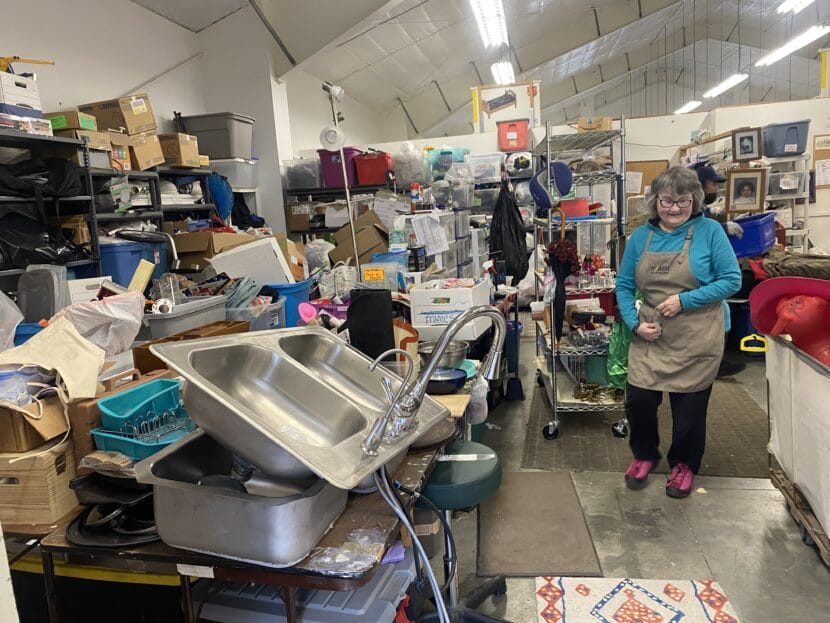
Mary Ellen Frank stuck around. She spends every third Saturday in the store’s back room, stationed in front of a giant sorting table, which has everything — a box of dented water bottles, a teasing comb in its original packaging from the 1960s, a vintage dissection kit in an alligator leather carrying case. And not one, but two kitchen sinks.
“I don’t know why the kitchen sink has to be there. I don’t even think I could pick that up,” Frank said. “That’s unusual. There’s always something new.”
Frank’s job is to decide what’s sellable. She’s an avid second-hand shopper herself — it’s how she sources materials as the curator of Juneau’s doll museum — so she approaches the table with an open mind.
“We’ve got a good balance of people that are kind of like, ‘Ehhh, get rid of it,’ Frank said. “And me like, ‘Ahhh, that has so much potential!’”
Still, Frank estimates they throw out about 20% of what gets dropped off. So far, she’s discarded some cloth face masks, a tote bag with torn handles and a scorched, stained potholder.
It’s not unheard of for people to donate straight up trash. Austin worries that could become more common because of rate hikes at the landfill.
Junk items can clog up operations at the St. Vincent De Paul thrift in the Mendenhall Valley, too, according to store manager Sharon Mallet. And at both stores, things that don’t sell within a few weeks have to be cleared to make more space on the store floor — which means some things might head to the landfill later.
Mallet said she does her best to prevent that, because she learned to make the most of secondhand materials while growing up in the Caribbean.
“I grew up on an island, so this to me — I think I just fit right in,” Mallet said. “I remember as a kid, you made everything last or you reused it a different way.”
Items that are beat-up but usable go to the Dan Austin Center Free Store. Shrunken wool sweaters get put aside for a local artist who makes mittens for people experiencing homelessness. And ripped cotton t-shirts become rags, which the store sells to boat owners or contractors.
Though the garbage collectors come once a week, Mallet said she can’t remember the last time the store’s dumpster was full.
Still, Juneau’s thrift stores say they can barely keep up, even for perfectly sellable items. Unlike the Salvation Army store, the St. Vincent De Paul store is open four days a week instead of just one. And they have more full-time staff.
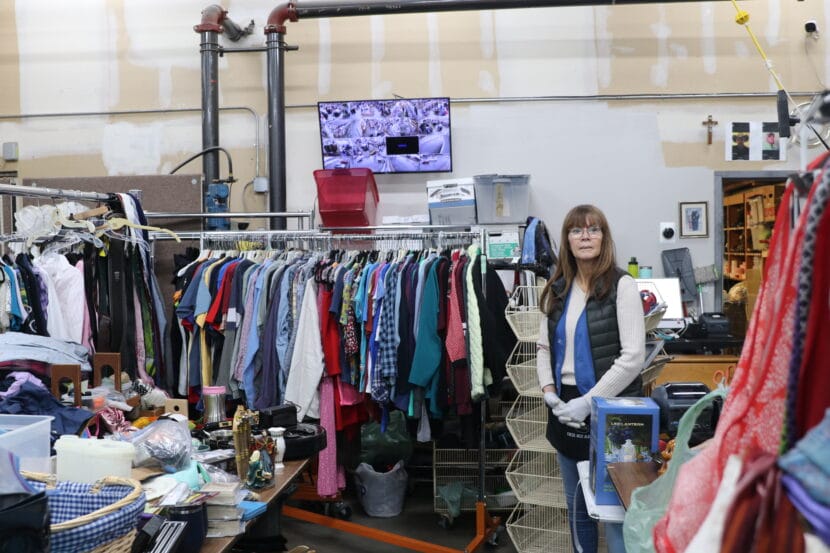
Even so, Mallet says they have to put a cap on how much stuff they can take.
“Because once we take it we also have to sort it, price it, hang it,” she said. “There’s a lot involved with it after we get it.”
In February alone they took more than 500 donations. By March, St. Vincent De Paul’s had posted a sign that said “No More Clothes” in the window by their donation drop-off.
“Clothing we have an abundance of,” Mallet said. “We never lack for clothing cause we get so many donated.”
Both stores say they receive an abundance of women’s clothes, especially shoes and accessories.
Some community organizers have started to hold occasional clothing swaps, to provide an alternative to thrift stores. Community Clothing Swap Juneau and the Southeast Alaska Gay Lesbian Alliance each hold one quarterly.
An old-timey solution
After local artist Mary McEwen submitted her Curious Juneau question, she found herself dreaming up her own ways to reuse old clothing that she and her friends had piling up.
“I was thinking about it in the context of Juneau, where like, if you can’t donate clothes, what do you do with them?” McEwen said. “And so that got me thinking about reuse. And that got me thinking about weaving.”
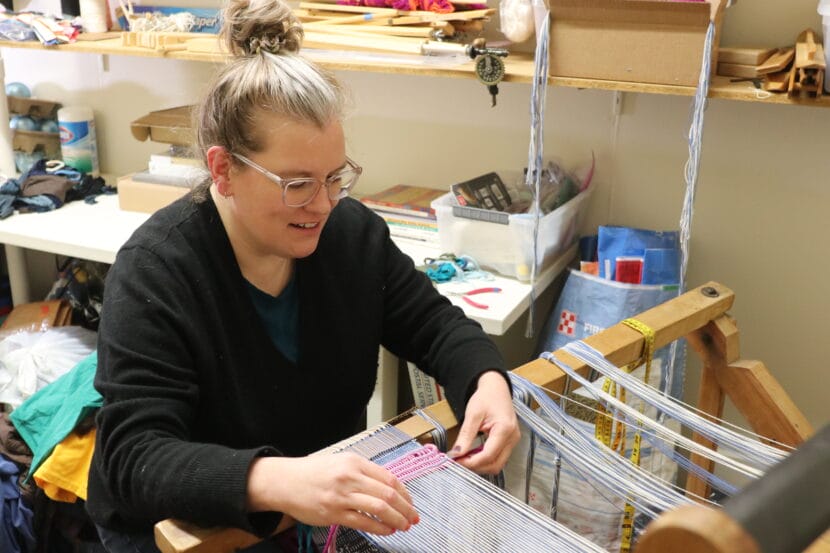
Though she had never woven before, McEwen bought a vintage loom on Craigslist. Now, three years later, her downtown weaving studio houses three wooden looms and a huge variety of used textiles. There’s a bag of worn-out pajama pants in one corner, a stack of misprinted t-shirts on the floor, and a big garbage bag full of socks.
There are a half-dozen multi-colored rugs around, and on every loom there’s a work-in-progress. One small rug incorporates strips of plastic bags. Another has alternating stripes of old jeans and a pink cotton sweatshirt.
McEwen uses the local thrift stores herself.
“I mean, everything I’m wearing, except for my socks and underwear, was thrifted,” McEwen said. “At this point in my life, I don’t buy any clothing firsthand.”
But she found herself frustrated when they couldn’t take donations. More than that, she found herself wondering what to do about clothes that don’t last long enough to make it to the second hand market.
“We have more like, fast fashion throwaway kind of stuff that doesn’t survive long enough, without falling apart to become something in a thrift store,” McEwen. “So I was thinking, you know, what if what if we use this kind of old-timey solution to this current problem?”
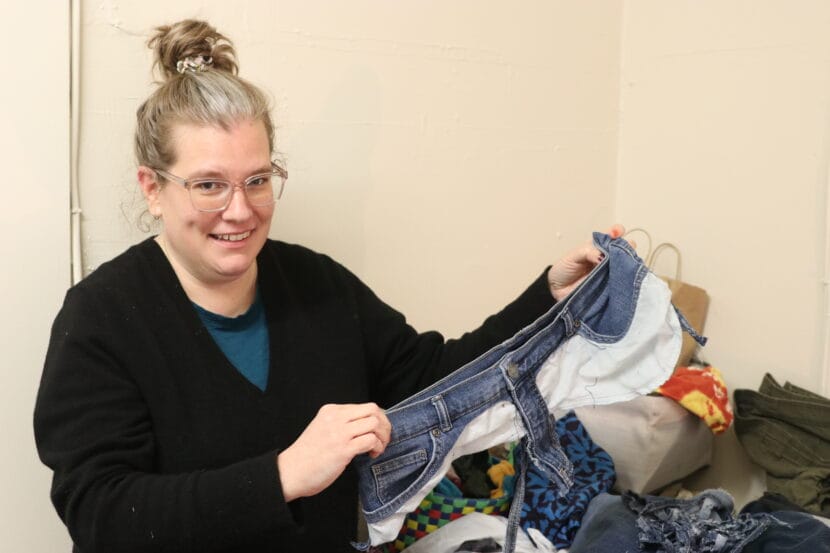
Rag rugs, which people have woven from scrap fabric for hundreds of years, became her answer. McEwen has been able to source most of her materials from friends and family — stuff they had a hard time donating but couldn’t bring themselves to throw out.
Though she advocates for reducing clothing purchases and mending or repairing garments when possible, McEwen said that using rugs to keep stuff out of the landfill has been a great challenge for her as an artist.
“I think, what color combinations am I going to use, and what other ways can I think of to elevate the aesthetics of it?” McEwen said. “Even though it is garbage, and even though we are going to step on it on the floor.”
Curious Juneau
Are you curious about Juneau, its history, places and people? Or if you just like to ask questions, then ask away!
